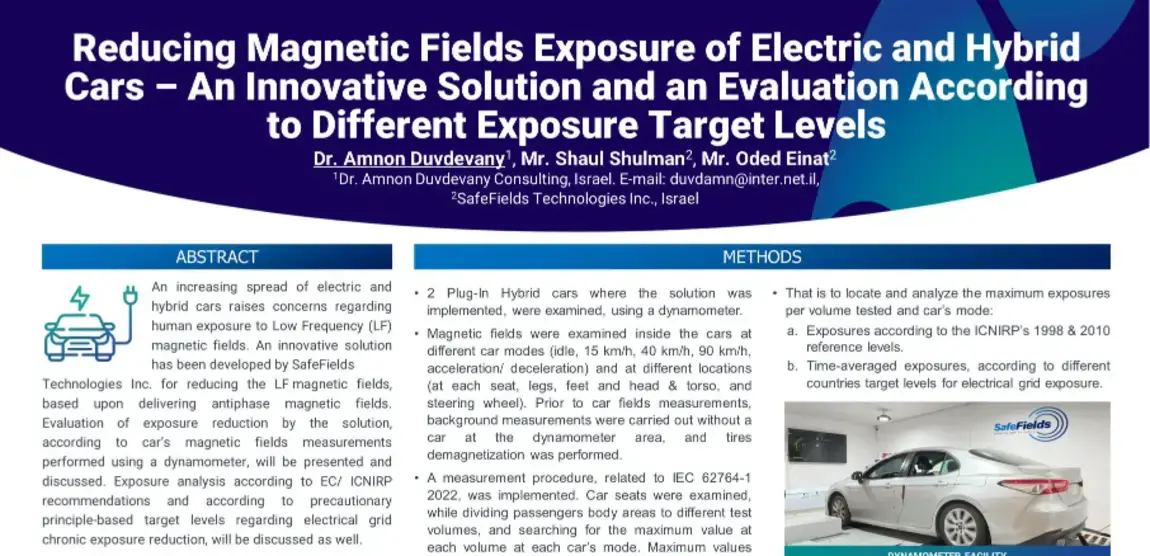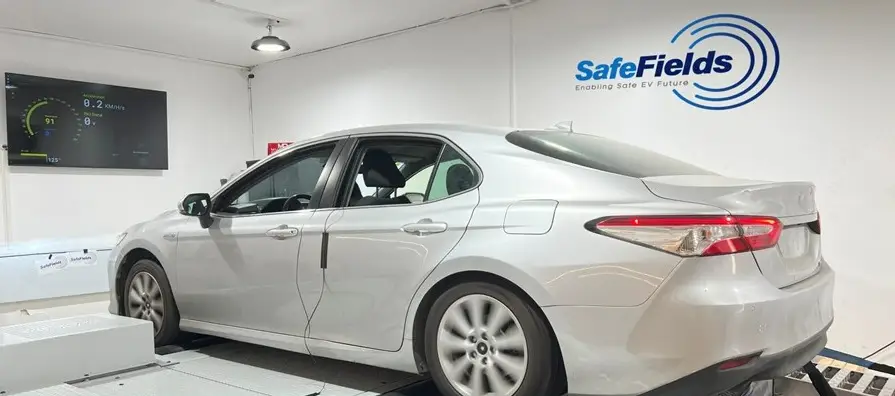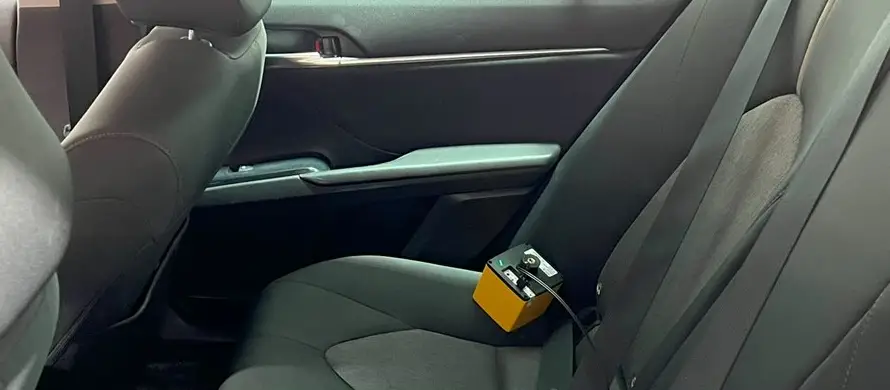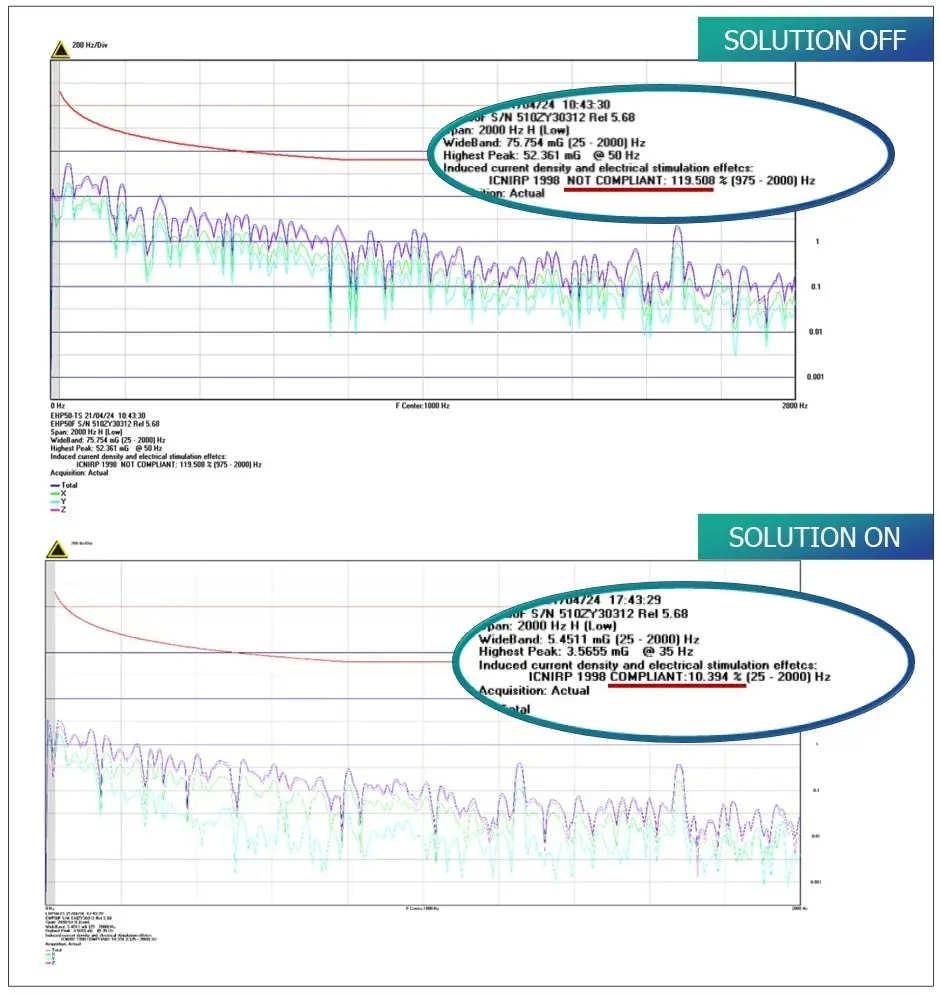BioEM 2024 Spotlight: Magnetic Field Exposure Cut in Popular EV with New In-Car Solution

As electric and hybrid cars become more common across the globe, new safety questions are coming up, especially about exposure to low-frequency magnetic fields. These vehicles help reduce emissions and limit reliance on fossil fuels. But they also bring new types of health concerns that are not always covered by today’s safety rules.
One study, shared at the BioEM 2024 conference, looked closely at this issue. Researchers from SafeFields Technologies Inc. and Dr. Amnon Duvdevany Consulting measured magnetic field levels inside a well-known plug-in hybrid electric vehicle (PHEV). While the study did not name the car directly, it is known in the industry as one of the most popular and widely sold models. Initial tests showed that the vehicle, in its factory setup, produced magnetic field levels that went beyond the safety limits recommended by the International Commission on Non-Ionizing Radiation Protection (ICNIRP), specifically the 1998 guidelines.
To address this, the team added a tailored solution designed to reduce magnetic field exposure. They tested the car again under different driving conditions. The results showed that the changes worked well: magnetic field levels dropped significantly and stayed within both international safety guidelines and stricter limits used in some countries as a precaution. This case shows why it’s important to regularly measure electromagnetic fields in electric cars and demonstrates that meaningful improvements are possible when proper solutions are applied.
The Problem: Magnetic Field Exposure in Daily Driving Still Goes Unnoticed
Electric and hybrid cars use strong electrical currents to move and manage their energy. These currents run through the vehicle’s motor, battery, and power electronics. As a result, they create low-frequency magnetic fields. These fields are not blocked by the car’s interior and can reach the passenger area.
To protect the public, ICNIRP issued exposure guidelines in 1998 and updated them in 2010. These limits are still commonly used today. However, they were not made for ongoing, long-term exposure inside electric vehicles. Nor were they created with modern EV systems in mind. In recent years, studies by groups like the European Commission’s Joint Research Centre (JRC) have found that many electric and hybrid cars can exceed those limits. Yet most people are still unaware of the issue.
In the car examined in this BioEM study, magnetic field levels (before any attempt to reduce them) went above the ICNIRP 1998 limits for public exposure. This was especially true in the back seats. The highest readings occurred during strong acceleration or while driving at fast speeds.
Methodology: Testing Inside the Car, Step by Step
This study tested two plug-in hybrid cars that used the same electric system. The cars were placed on a dynamometer, which mimics real road conditions. Tests were run during different phases: while idling (in both electric and fuel modes), at steady speeds (15, 40, and 90 km/h), and during acceleration and braking. Magnetic field levels were measured using a Narda STS EHP-50F probe. This device can detect fields from 1 Hz to 400 kHz, covering the full range that may affect human biology or matter for regulation.

Measurements were done according to the IEC 62764-1 standard (2022 edition), which is the current guideline for checking magnetic fields inside vehicles. Each seat was divided into four zones that match primary parts of the body: head, chest, legs, and feet. This helped find out which parts of the body receive the highest exposure at different times during the drive.
The first round of testing was done without any changes to the cars. Once those results were recorded, SafeFields added its active cancellation system. This system uses special coils that send out magnetic fields in the opposite direction of the harmful ones. These coils are placed in primary spots in the car and adjust in real time depending on driving power and load. The goal is to keep the magnetic field low across all driving conditions.

Results: Consistent and Documented Reduction in Magnetic Field Levels
The intervention produced clear and repeatable improvements under all measured driving conditions.
In Car A, magnetic field levels during acceleration dropped significantly, from 57.6 milligauss (mG) down to 7.2 mG. This corresponds to an 87.5% reduction in exposure. Before the solution was applied, levels exceeded the ICNIRP 1998 limits for the general public. After activation, all readings complied with the guideline.
CAR A
| STATE | AVERAGE LEVELS [mG] | % ICNIRP 1998, GP | % ICNIRP 2010, GP | ||||||
| Solution Off | Solution On | % ON/ OFF | Solution Off | Solution On | % ON/ OFF | Solution Off | Solution On | % ON/ OFF | |
| IDLE, ELE | 35.76 | 5.1 | 14.2 | 76.4 | 9.4 | 12.3 | 4.8 | 0.23 | 4.7 |
| IDLE, ICE | 46.6 | 5.9 | 12.8 | 103.2 | 13.6 | 13.2 | 8.0 | 0.2 | 2.8 |
| 15 km/h, ELE | 37.3 | 4.8 | 12.8 | 52.0 | 9.6 | 18.4 | 4.2 | 0.2 | 4.5 |
| 15 km/h, ICE | 46.1 | 6.5 | 14.0 | 93.1 | 14.7 | 15.8 | 7.3 | 0.4 | 5.2 |
| 40 km/h | 37.1 | 6.0 | 16.1 | 63.4 | 9.5 | 14.9 | 4.8 | 0.6 | 12.1 |
| 90 km/h | 38.7 | 10.7 | 27.7 | 53.1 | 11.4 | 21.5 | 9.4 | 1.2 | 12.7 |
| Acceleration | 57.6 | 7.2 | 12.5 | 134.1 | 27.4 | 20.4 | 13.5 | 0.8 | 5.8 |
Car B showed a similar outcome. At a steady speed of 90 km/h, magnetic field strength was reduced from 60.0 mG to 10.2 mG, only 17% of the original value. The highest exposures were consistently recorded in the rear right seat, an area commonly affected due to its proximity to the vehicle’s powertrain and cabling layout.
CAR B
| STATE | AVERAGE LEVELS [mG] | % ICNIRP 1998, GP | % ICNIRP 2010, GP | ||||||
| Solution Off | Solution On | % ON/ OFF | Solution Off | Solution On | % ON/ OFF | Solution Off | Solution On | % ON/ OFF | |
| IDLE, ELE | 17.1 | 2.1 | 12.5 | 28.1 | 2.4 | 8.4 | 3.4 | 0.05 | 1.4 |
| IDLE, ICE | 52.8 | 4.5 | 8.6 | 72.4 | 6.5 | 9.0 | 8.3 | 0.2 | 2.6 |
| 15 km/h, ELE | 27.0 | 2.1 | 7.9 | 35.2 | 11.8 | 33.5 | 3.9 | 0.3 | 7.7 |
| 15 km/h, ICE | 63.3 | 9.7 | 15.4 | 122.3 | 11.8 | 9.6 | 12.4 | 0.3 | 2.4 |
| 40 km/h | 59.6 | 4.8 | 8.0 | 128.6 | 36.6 | 28.5 | 16.5 | 0.8 | 5.1 |
| 90 km/h | 60.0 | 10.2 | 17.0 | 170.3 | 27.7 | 16.2 | 18.1 | 1.4 | 7.5 |
| Acceleration | 82.2 | 8.1 | 9.8 | 145.3 | 33.0 | 22.7 | 12.8 | 0.6 | 4.5 |
When evaluated against stricter benchmarks, such as national guidelines in several countries that suggest keeping long-term public exposure below 10 mG, post-intervention readings remained within recommended limits. In some test points, final field values were found to be under 1% of the ICNIRP 2010 basic restriction.
The most substantial reduction was observed during load-intensive scenarios like acceleration and high-speed driving. These are precisely the situations where transient peaks tend to occur and where occupant exposure would otherwise be highest.

Implications for Regulation and Public Safety
The results shown in this study raise several important issues. Although public awareness is growing and the scientific findings are becoming harder to ignore, current regulations still fall short.
In many countries, there are no laws that require car makers to limit magnetic field exposure inside vehicles. The IEC 62764-1 standard describes how to measure these fields accurately, but it does not set a maximum allowed value. Similarly, ICNIRP guidelines are advisory in nature. They are not enforced by law in most parts of the world.
Still, organizations like the World Health Organization (WHO) and the European Union recommend applying the precautionary principle, especially where people are exposed for long periods. Some countries, including Israel, Belgium, Switzerland, and Italy, have already introduced rules or building codes aimed at keeping low-frequency magnetic fields to a minimum in:
- Schools
- Homes
- Public spaces
The car industry, however, has not made similar moves.
What this BioEM 2024 study shows is that large reductions (up to 80–90 percent) in magnetic field exposure are possible in electric vehicles using relatively simple design changes. This leads to an important question: if the fix is both technically practical and cost-effective, why has it not become a standard requirement across all new vehicles?
Toward Safer Vehicle Designs
The deployment of SafeFields’ active cancellation method illustrates that reducing magnetic field exposure inside vehicles is not only technically possible, but can be done without major changes to the vehicle.
Unlike traditional shielding methods that involve bulky materials or structural modifications, this system uses calibrated counter-fields that adjust in real time to the vehicle’s electrical environment. This allows the solution to be tuned for different car models without compromising protection performance under varying driving conditions.
The technology has already been integrated into several hybrid and fully electric vehicles. Field validation across these models confirms the effectiveness reported in the BioEM study. This provides a working example of how exposure risks can be addressed by manufacturers before regulations require action, by embedding exposure reduction into vehicle development from the outset.
Call for Greater Transparency
Despite increasing public interest in electromagnetic exposure, current industry practices do not require car manufacturers to report magnetic field levels inside the passenger cabin. This differs from other vehicle performance indicators, such as emissions or fuel consumption, which are subject to testing and must be disclosed to consumers.
As a result, individuals (especially those in sensitive groups such as pregnant women, young children, or people with electromagnetic hypersensitivity) are left without access to relevant exposure data. While some third-party measurements exist and are occasionally published by research institutions or consumer safety outlets, the information is inconsistent and not uniformly applied across vehicle models.
To close this information gap, it would be advisable for regulatory authorities and automotive standards bodies to define uniform test protocols for in-cabin magnetic field levels and include those results in the vehicle’s official safety documentation. This would support informed consumer decisions and incentivize manufacturers to integrate exposure mitigation into future vehicle designs.

